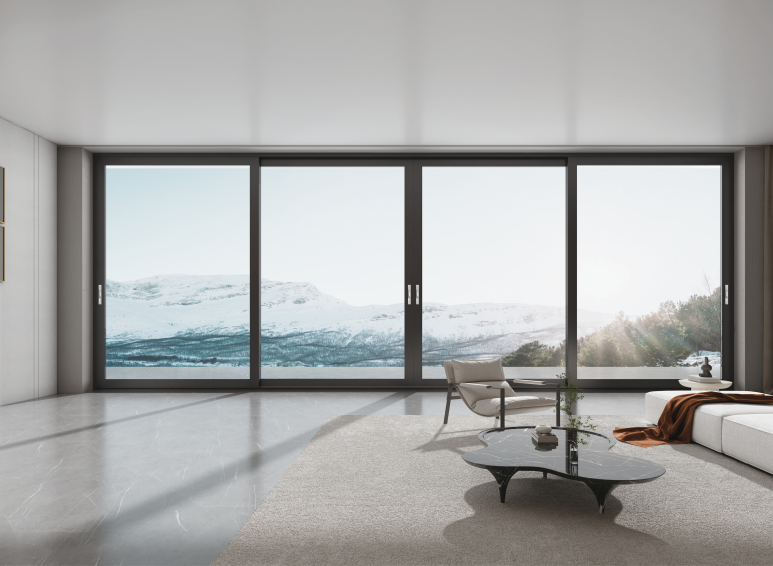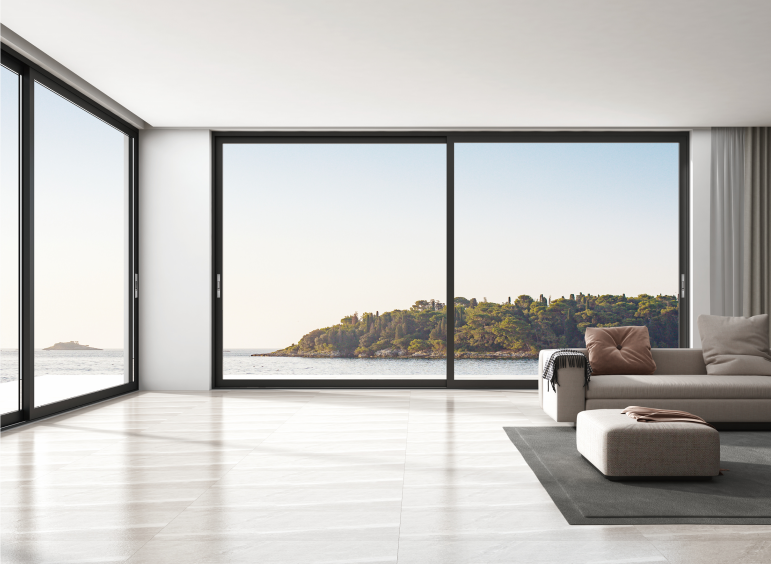Heavy-duty sliding doors, commonly used as entrances or partitions in wide-open spaces like villas and condominiums, offer wide views, flexible opening methods, and a stable structure, making them a crucial element in enhancing living quality. Compared to ordinary sliding doors, they demand higher performance in terms of load-bearing capacity, wind resistance, and sealing. When choosing a heavy-duty sliding door, it's important to look beyond superficial appearance and thoroughly consider core performance dimensions such as material, structure, hardware, and sealing. The following analyzes the key factors in choosing a heavy-duty sliding door based on six key performance factors, providing consumers with a sound basis.

1. Material Performance: Laying the Foundation for Stability and Durability
The material is the core factor that determines the performance ceiling of a heavy-duty sliding door, requiring a balance of strength, weather resistance, and texture. Different materials vary significantly in their application scenarios and performance, so a comprehensive selection should be made based on the usage environment (indoor/outdoor, street-facing, etc.). 1. Profile Material: The Core of Load-Bearing and Deformation Resistance
The profiles for heavy-duty sliding doors must possess high load-bearing capacity, bend resistance, and resist deformation. Aluminum alloy is the primary material. Pay special attention to the profile's material purity, cross-sectional structure, and thickness:
Material Purity: Preferred are virgin aluminum alloy profiles, which have an aluminum content of ≥95%, few impurities, and high strength (tensile strength ≥110 MPa, yield strength ≥90 MPa). They are less susceptible to cracking and fading with long-term use. Be wary of recycled aluminum profiles (commonly known as "recycled aluminum"). These profiles contain many impurities, are prone to dark spots on the surface, and are prone to bending and deformation under load. You can identify these by observing their color and testing their hardness. Virgin aluminum profiles have a uniform gloss with no noticeable color variation. A light scratch with a key leaves only a shallow mark. Recycled aluminum, on the other hand, tends to leave deep marks and may be accompanied by debris. Cross-sectional Structure: High-quality profiles utilize a "multi-cavity structure," dividing the cross-section into multiple independent cavities. This reduces weight (reducing the load-bearing pressure on the track) while enhancing wind resistance and sound insulation. This makes them particularly suitable for exterior sliding doors located on high floors or facing the street. Attention should also be paid to the profile's "reinforcement rib design." Ribs ≥1.2mm thick should be installed in stress-bearing areas such as the door frame and track bottom to improve bending resistance and prevent sagging caused by long-term hanging of the door.
Profile Thickness: The door frame profile thickness must be ≥1.4mm (≥1.6mm is recommended for exterior doors), and the track profile thickness must be ≥2.0mm. Profiles that are too thin will have insufficient load-bearing capacity, leading to track deformation and door sway. When purchasing, check the product inspection report to confirm that the profile thickness meets national standards, or measure it on-site with a caliper (measure on the uncoated surface of the profile to avoid any influence from the coating thickness).
2. Glass Configuration: Balancing Safety, Soundproofing, and Energy Efficiency
Glass is a crucial component of heavy-duty sliding doors, accounting for over 70%. Its performance directly impacts safety, soundproofing, and thermal insulation. The appropriate glass configuration should be selected based on the intended use scenario:
Safety Glass: Tempered or laminated glass is mandatory. Ordinary float glass is prohibited (it is fragile and its shattered fragments are sharp, posing a safety hazard). Tempered glass must comply with GB 15763.2 and be ≥5mm thick. Shattered glass forms small, blunt-angled fragments, minimizing injury. Laminated glass consists of two or more sheets of glass sandwiched between a PVB film. Even if broken, the film holds the fragments together, preventing them from falling. It is suitable for high-rise exterior doors or homes with children. If the glass area is ≥1.5㎡, a "tempered + laminated" composite glass (e.g., 5mm tempered + 0.76mm PVB + 5mm tempered) is recommended for both safety and impact resistance. Soundproof glass: For street-facing or noisy areas, choose insulating glass with a core thickness of 12mm or greater (the thicker the core, the better the sound insulation; 12-20mm is recommended). This core should be filled with dry air or argon (argon is an inert gas with superior sound and thermal insulation properties to air). The glass should also be constructed with different thicknesses (e.g., 5mm + 12A + 6mm, where "A" represents the thickness of the core). This thickness difference reduces acoustic resonance and improves sound insulation (reducing noise by 30-40 decibels, meeting daily quiet requirements). Be aware that low-quality insulating glass may have a "false core" (directly bonded to the glass with sealant, without aluminum spacers or desiccant), making it prone to fogging and water ingress. Check the glass edges when purchasing. High-quality insulating glass has silver aluminum spacers (with built-in desiccant) and a rich, bubble-free sealant. Energy-saving glass: For homes focused on thermal insulation, Low-E (low-emissivity) insulating glass can be an option. Coated with a thin metal film, the glass reflects infrared rays, preventing heat loss in winter and heat in summer, improving air conditioning efficiency. Low-E glass is available in two types: online and offline. Offline Low-E glass offers superior sound insulation and thermal insulation, but requires insulating glass (to prevent film oxidation). It is suitable for those in cold northern regions or those with high energy-efficiency requirements.

2. Structural Performance: Ensuring Stability and Smooth Operation
The structural design of heavy-duty sliding doors directly impacts the user experience and service life. Special attention should be paid to the track, door leaf suspension method, and wind pressure resistance to avoid problems such as door leaf wobbling, jamming, and sagging.
1. Track Structure: Key to Load-Bearing and Smooth Operation
The track is the "foundation" of a heavy-duty sliding door and must be highly load-bearing, wear-resistant, and resilient to deformation. Three key considerations should be considered: track type, material, and drainage design:
Track Type: An "upper-track load-bearing" design is preferred (meaning the weight of the door leaf is borne by the upper track). This type of track distributes force more evenly, preventing deformation of the lower track due to long-term load bearing. It also eliminates raised tracks on the floor (only lower guide strips are required), making it easier for robot vacuums to navigate and suitable for homes with elderly and children. While a lower-track load-bearing design (where the weight is borne by the lower track) is simple to install, the lower track is prone to dust and water accumulation, can become jammed over time, and presents a tripping hazard. Therefore, it is only recommended for less frequently visited areas such as outdoor terraces. Track Material: Tracks should be made of 304 stainless steel or high-strength aluminum alloy. 304 stainless steel tracks are wear-resistant and corrosion-resistant (suitable for humid environments such as balconies and courtyards). The surface should be brushed or polished to reduce friction. Aluminum alloy tracks should be anodized (thickness ≥ 10μm) to increase surface hardness (≥ HV150) and prevent scratches caused by long-term friction. The track's cross-sectional width should match the door leaf. The recommended upper track width is ≥ 40mm, and the lower guide strip width is ≥ 20mm. This ensures the door leaf is securely suspended and prevents swaying.
Drainage Design: Exterior heavy-duty sliding doors must have a comprehensive drainage system to prevent rainwater from seeping into the room and rusting the track. High-quality tracks will have hidden drainage holes at the bottom with a diameter of ≥ 8mm. Each hole has a separate drainage channel to prevent water from clogging and spreading. A water barrier ≥ 5mm high should be installed on the inside of the track to prevent rainwater from seeping into the wall through the track gaps. When purchasing, pour a small amount of water into the track to check for smooth drainage and no residual water.
2. Door Leaf Structure: Wind Pressure Resistance and Stability
Heavy-duty sliding doors typically have large leaf areas (single leaf widths can reach 1.2-1.8m and heights can reach 2.4-3m). They require excellent wind pressure resistance to prevent swaying or damage in windy conditions:
Frames and Muns: Door leaf frames must be constructed of thickened profiles (thickness ≥ 1.6mm). If the door leaf height is ≥ 2.4m, a mun (a horizontal or vertical reinforcement bar) must be installed. The mun and frame should be fixed with mortise and tenon joints and screws to enhance overall door leaf rigidity and prevent bending due to weight or wind pressure. The number of muns is determined by door leaf size; generally, one mun is added for every 0.6m increase in height.
Glass Fixing Method: The glass and profile should be fixed using a dual method of "structural adhesive + glass molding." Choose neutral silicone adhesive (highly weather-resistant and less prone to cracking) for structural adhesive, ensuring a tight fit between the glass and profile. The glass molding should be made of aluminum alloy (to prevent plastic molding from aging and deformation). The molding and profile should be connected with snaps, leaving no noticeable gaps to prevent the glass from loosening or water intrusion. EPDM foam strips should also be installed between the glass and profile to cushion glass vibrations and enhance sealing.

3. Hardware Performance: Determines Smoothness and Lifespan
The hardware of heavy-duty sliding doors is the "power system," responsible for suspending, sliding, and positioning the door leaf. Its quality directly impacts the smoothness of opening and closing and its lifespan. Pay special attention to the performance of core hardware components such as pulleys, handles, and limiters. 1. Pulleys: The Core of Smooth Sliding
Pulleys must bear the full weight of the door leaf (a single door leaf can weigh up to 80-150kg) and must be high-load-bearing, wear-resistant, and low-noise.
Material and Construction: Preferred pulleys are stainless steel bearings. The pulley housing should be 304 stainless steel (corrosion-resistant) and internally use high-precision ball bearings (≥6). Grease should be filled with grease (high-temperature resistant and non-lubricating) to ensure smooth rotation without sticking or unusual noise. The pulley's tread should be made of rubber or nylon (hardness ≤ 70 Shore A). This increases friction with the track (preventing the door leaf from sliding too quickly) and reduces friction noise (sliding noise ≤ 40 decibels, comparable to ambient library noise). Avoid plastic pulleys (which are prone to aging and cracking) or ordinary carbon steel bearing pulleys (which are prone to rust and have high rotational resistance). Load-bearing capacity and quantity: A single pulley must have a load-bearing capacity of ≥80kg. Each door leaf should be equipped with 4-6 pulleys (evenly distributed on both sides of the upper track) to ensure weight distribution and prevent damage to a single pulley due to overload. When purchasing, check the pulley's test report to confirm its load-bearing capacity, or conduct an on-site test. Apply even force when pushing the door leaf, ensuring no noticeable resistance. After releasing the pulley's grip, the door leaf should slide slowly (without jerking or sudden acceleration), and without any jarring noise.
Anti-slip design: Pulleys must have an anti-slip structure, either with a rib (≥5mm in height) on the outside of the pulley or a groove on the inside of the upper track. This prevents the door leaf from sliding due to vibration or wind pressure. This is particularly suitable for use in high-rise buildings or in windy areas. Gently shake the door leaf. If there is no noticeable movement or loosening, the anti-slip design is reliable. 2. Handles and Locks: Balancing Convenience and Security
Handles and locks must balance convenience and security. Especially for exterior sliding doors, the anti-theft performance of the lock is crucial:
Handle Material and Feel: Choose aluminum alloy or zinc alloy (with an electrophoretic or spray-coated surface for corrosion and scratch resistance), provide a comfortable grip (diameter ≥ 30mm, length ≥ 120mm), and be free of sharp edges. The handle must be securely connected to the door leaf, using stainless steel mounting screws (length ≥ 25mm). After tightening, the handle should not loosen or wobble, and should not sag when turned.
Lock Performance: For exterior sliding doors, it is recommended to choose a "multi-point lock" (with ≥ 3 locking points, distributed on the top, bottom, and sides of the door leaf). When closed, these locking points engage tightly with the door frame's striker, enhancing anti-theft performance and sealing, preventing forced prying. The lock cylinder must be a Class C cylinder (technical opening time ≥ 270 minutes), and the key must be a blade or quantum key. Its resistance to prying and technical opening is superior to that of Class A and Class B cylinders. Furthermore, the lock must be corrosion-resistant and suitable for humid outdoor environments. Nickel or chrome plating is recommended to prevent rust.
3. Stoppers and Buffers: Ensuring Safety
Stoppers limit the sliding range of the door leaf, preventing it from striking the door frame; buffers slow the door leaf's closing speed to prevent pinching or damage. Both are essential safety components:
Stoppers must be installed at both ends of the track. Made of stainless steel or aluminum alloy, they feature an "elastic buffer" function (built-in springs or rubber pads). When the door leaf reaches the end of the track, the stoppers cushion the impact, preventing direct collision with the door frame. The stoppers must be securely connected to the track (screwed securely, without looseness) and withstand an impact force of ≥ 500N (approximately 50kg) without deformation or damage. Buffers: We recommend a "bidirectional buffer" (which provides buffering for both opening and closing). Installed on the upper track or at the top of the door, it should have a travel of 30mm or greater and an adjustable force (adjusted to the door's weight to avoid excessive or too little buffering). During testing, push the door quickly. The buffer should smoothly slow the door, allowing it to close slowly without any sudden stops or thumping. If the buffer maintains its position after closing (without sliding), this indicates reliable performance.
IV. Sealing Performance: Balancing Sound Insulation, Thermal Insulation, and Dustproofing
The sealing performance of heavy-duty sliding doors directly impacts indoor comfort. A good seal effectively isolates outdoor noise, dust, and rainwater. A comprehensive assessment of both the sealing structure and the sealing materials is required.
1. Sealing Structure: Multi-dimensionally blocking external interference
High-quality heavy-duty sliding doors should utilize a "triple sealing structure," covering the three major connections between the door leaf and door frame, between the door leaf and door leaf, and between the door leaf and track.
Leaf-to-frame sealing: Two to three sealing strip grooves should be provided on the inside of the door frame, located at the top, bottom, and sides of the door leaf. The strips should encircle the entire door leaf, forming a closed-loop seal. The door frame-to-wall connection should be filled with high-density foam (expansion rate ≥ 200%) and coated with weather-resistant sealant (silicone or polyurethane). The seam width should be ≥ 5mm, with a smooth, continuous surface free of bubbles or cracks, to prevent rainwater from seeping through the gap between the wall and door frame. Door-to-door sealing: Double or multi-leaf sliding doors require the installation of "staggered seals" or "center seal strips" in the center gap. Staggered seals reduce the gap width (≤ 2mm) by staggering the two door leaves. The center seal strip is made of EPDM foam (highly elastic and resistant to aging) and is installed on the side of one door leaf. When closed, the strip mates tightly with the other leaf, isolating noise and dust. Some high-end models also feature "magnetic seals" in the center gap, which enhance sealing through magnetic attraction.
Door-to-track sealing: The bottom of the door leaf should be equipped with an "automatic lifting seal strip." When closed, the seal strip automatically descends (height ≥ 8mm) to securely contact the track, isolating dust and rainwater from the bottom. When opened, the seal strip automatically rises to prevent friction with the track (extending the life of the seal strip). Side seal strips should be installed on the inside of the track, mate with the side of the door leaf, further enhancing sealing performance. 2. Sealing Material: Critical to Sealing Effectiveness
The sealing material must be highly elastic, weather-resistant, and durable. The core sealing component is the rubber strip, so the material and performance should be of particular concern:
Rubber Strip Material: EPDM (ethylene propylene diene monomer) is preferred. It offers strong weather resistance (withstands temperatures ranging from -40°C to 80°C), excellent aging resistance (lifespan ≥ 10 years), good elasticity (compression set ≤ 20%), and resistance to hardening and cracking with long-term use. PVC rubber strips should be avoided (they tend to harden at low temperatures, soften at high temperatures, and have a lifespan of only 2-3 years). You can determine this by observing its elasticity and smelling it: EPDM rubber strips quickly rebound when stretched and have no noticeable odor. PVC rubber strips tend to break easily after stretching and have a pungent odor. Gasket Installation: The gasket must fit snugly into the profile's gasket groove, ensuring no loosening or falling off. Joints must be spliced at 45 degrees or heat-welded to avoid gaps. (Welded joints must be smooth and burr-free.) The gasket must also be sufficiently compressed (compression ratio ≥ 30%) to ensure it fully compresses when the door leaf is closed, creating an effective seal. If the gasket is too loose (compression ratio less than 20%), the sealing effect will be poor. If it is too tight (compression ratio exceeding 40%), it will increase sliding resistance, making opening and closing difficult.
5. Wind and Weather Resistance: Adapting to Complex Outdoor Environments
If heavy-duty sliding doors are used outdoors (such as patio doors or terrace doors), they must possess excellent wind and weather resistance to withstand the effects of strong winds, rain, UV rays, and other external factors to prevent damage from long-term use. 1. Wind Pressure Resistance: Choose Based on Installation Height
Wind pressure resistance should be determined based on the floor level and wind speed in the area. National standards categorize wind pressure resistance on a scale of 1-9 (1 being the lowest and 9 being the highest). For high-rise residential buildings (10 stories and above) or windy coastal areas, it is recommended to choose products with a wind pressure resistance of ≥6 (withstanding wind pressures of ≥3.0 kPa, approximately equivalent to a force 10 gale). For low-rise residential buildings (1-9 stories), choose products with a wind pressure resistance of ≥4 (withstanding wind pressures of ≥1.5 kPa, approximately equivalent to a force 8 gale). When purchasing, check the product test report to confirm the wind pressure resistance rating, or observe the door leaf structure—doors with multi-cavity profiles, muntins, and reinforced ribs are more likely to have better wind pressure resistance. 2. Weather Resistance: Resistant to Environmental Attacks
Weather resistance primarily includes resistance to UV rays, corrosion, and rainwater penetration. This requires consideration from three aspects: profile surface treatment, hardware protection, and sealant weather resistance.
Profile Surface Treatment: Aluminum alloy profiles require surface treatment. Common methods include anodizing, powder coating, and fluorocarbon spraying. Anodizing (thickness ≥ 10μm) offers excellent corrosion resistance and is suitable for humid environments; powder coating (thickness ≥ 60μm) offers rich colors and excellent UV resistance (resistance to fading); fluorocarbon spraying (thickness ≥ 40μm, with at least two coats and one bake) offers the best weather resistance, withstanding long-term UV exposure and rain, with a color retention rate of ≥ 90% (service life ≥ 20 years), making it suitable for coastal areas or areas with strong UV rays. When purchasing, check that the surface coating is evenly distributed, free of sags, pinholes, or scratches, and leaves no visible marks after light scratching with a fingernail. Hardware Protection: Hardware should be treated with corrosion protection, such as brushed or polished stainless steel hardware and nickel or chrome plating (coating thickness ≥ 8μm) for zinc alloy hardware, to prevent rust from prolonged exposure to moisture. Moving parts such as pulleys and handles should be lubricated regularly (silicone-based grease is recommended every six months) to maintain smooth rotation and extend service life.
Weather-resistant sealants: For sealants connecting door frames to walls and structural adhesives connecting glass to profiles, choose highly weather-resistant products, such as silicone weather-resistant adhesive (operable temperature range -50°C to 150°C, service life ≥10 years). Avoid using ordinary glass glue (which is prone to aging and cracking, with a service life of only 2-3 years). After application, the sealant should be smooth and flat, free of bubbles or gaps, to prevent rainwater from penetrating. 6. Installation and After-Sales Service: Ensuring Full Performance
The installation quality of heavy-duty sliding doors directly impacts their performance. Even if the product itself performs excellently, improper installation can lead to problems such as door leaf jamming, poor sealing, and sagging. Pay close attention to installation techniques and after-sales service.



